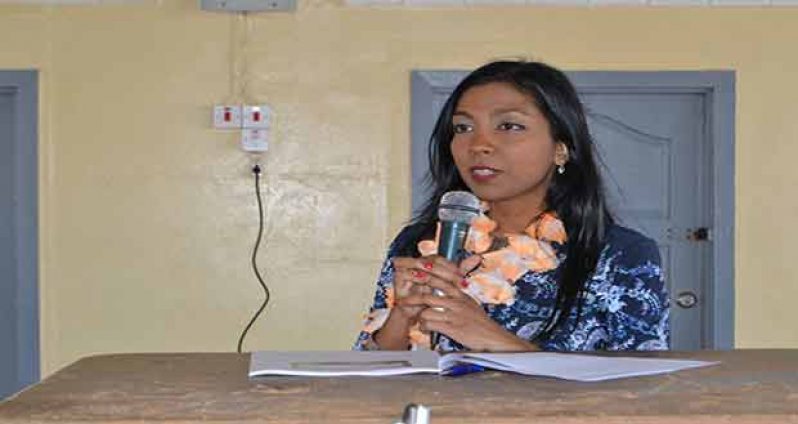Georgetown GINA, February 20, 2015
AS government continues on its voyage to promote economic growth while combating climate change, residents of various communities in Region Five were, on February 18, educated on the country’s Low Carbon Development Strategy (LCDS), as the Office of Climate Change (OCC) conducted an awareness session at the Regional Democratic Council building in Fort Wellington.
Regional Chairman, Bindrabhan Bisnauth, chaired the session, which featured several key presentations from officials of the OCC and the Ministry of Agriculture.
Head of the OCC, Gitanjali Chandarpal, in her presentation at the national stakeholder outreach and awareness meeting, explained to the large gathering that climate change is the change of weather patterns over a long period of time. She added that the climate has been changing rapidly due to the increase in greenhouse gas emissions.
Ms Chandarpal stated that over the last century temperatures increased by approximately 1 degree Celsius due to the significant increase in the level of carbon dioxide (Co2) in the atmosphere over the past 100 years.
She added that this is resulting in the rising of the sea levels which is one of the consequences to Guyana. The country has been experiencing some unusual and extreme weather patterns such as intense rainfall, as well as dry periods.
These weather patterns not only pose a threat to the agriculture sector, but also to human health and existence in general. She added that by the end of this century temperatures can rise by up to 4 degrees Celsius. She stated that 2014 was one of the hottest years in recorded history and there is need to address the impacts of climate change now.
She also acknowledged that in this respect, there are two major factors in addressing climate change: mitigation which includes reductions in the levels of carbon dioxide, and adaptation, which is understanding the situation and adjusting to cope with it.
In addressing climate change locally and attempting to manage the forests, Guyana has undertaken several initiatives. Most notably in 2009, the LCDS was launched. It seeks to enable a development pathway for Guyana, which balances economic development and sustainability.
It was mentioned that Guyana has also been creating partnerships locally and internationally. She alluded to the fact that in 2009, Guyana and Norway signed a Memorandum of Understanding (MoU). This agreement saw a commitment from Norway to provide Guyana with up to US$250M by 2015 for its work on Reducing Emissions from Deforestation and Forest Degradation (REDD+). She further noted that of this sum, the country has thus far successfully received US$150M.
This money has been used as investments in priority projects under the LCDS, and is being used to fund several projects in mitigation and adaptation such as Micro and Small Enterprise Development, Climate Resilience Strategy and Action Plan, and the Amaila Falls Hydropower Project, among others.
Another very important project under this agreement is the Cunha Canal rehabilitation project which is expected to improve the drainage capacity of the East Demerara Water Conservancy (EDWC) system.

Also, projects such as the biodiversity research centre, the development of a climate resilience strategy and action plan and the LCDS outreach project is also funded under the Guyana REDD+ Investment Fund (GRIF).
Further, finance from this grant is also used to fast track the Amerindian Land Titling project. She noted that the LCDS will also support ecotourism and aquaculture initiatives, among other areas.
Permanent Secretary of the Ministry of Agriculture, George Jervis, indicated that the Ministry has carried out and is currently implementing several projects in the area of agriculture and climate change.
He pointed out to the large gathering of residents, representatives of various governmental, NGOs and others that government has realised that the region is a high production area and it has been working to put measures in place to deal with the issue of climate change.
Jervis noted that Region Five contributes 40% of the country’s rice production, 30-35% cattle rearing and 10-15% sugar production in the country.
He further pointed out that the Ministry has budgeted $350M for works on the sluice at De Edward as it has recognised that that is one of the main sluices in the region.
He alluded to the planting and perseveration of mangroves project by the Ministry to protect the communities from the sea.
There has also been the promotion of technologies such as drip irrigation, sprinkler and micro-sprinkler systems, greenhouses, modern farming techniques such as hydroponics, and plastic mulch among others.
Meanwhile, Ms Hymawattie Lagan, member of the Multi-Stakeholder Steering Committee (MSSC) of the LCDS and Head of the Women’s Affairs Bureau (WAB) urged the participants to help in the battle against climate change.
A few weeks ago, the OCC conducted similar sessions to residents in Regions Seven and Eight. These sessions are intended to create awareness on the issue of climate change and the country’s approach towards it, specifically the LCDS. (GINA)




.png)









